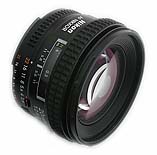Autofocus
Nikkor 20mm f/2.8D |
||||||
| Nikon's bread and butter fixed wide angle lens.
The BasicsReaders of my earliest lens review (20-35mm f/2.8D) know that I like wide angle lenses. For many years, my three favorites were the Sigma 14mm, the Nikkor 24mm f/2.8D, and the object of this review, the 20mm f2.8D. Nikon has made eight 20mm lenses:
The last three of these lenses all share a 12/9-element lens design and 62mm filter size, though for some reason the non-D autofocus version didn't focus quite as close as the other two (12" versus 10").
This Nikkor has a fixed f/2.8 aperture, with a minimum aperture of f/22. Focusing can be as close as 10 inches (0.25m). The front element does not move during focus changes. The D in the name means that focus distance is used in flash and metering calculations by the camera. The focus ring is narrow, but easily distinguished by its knurled rubber pattern. Up front, you'll be screwing in 62mm accessories, Nikon's midrange standard, shared by a number of other popular lenses. You'll have to pay extra for the optional bayonet hood (HB-4) and lens pouch (No. 61). Amazingly, this lens is physically shorter than the 24mm f/2.8D, and almost as light, despite a bigger front element. On my F5, the 20mm f/2.8D barely sticks out past the grip. At 9.5 ounces, there's no reason not to carry this Nikkor with you--it's now a permanent part of my hiking kit.
HandlingMany old-time Nikon users bemoan the focus "feel" of autofocus Nikkors. While I've got my share of loosy-goosy focus rings, the 20mm f/2.8D is not one of them. No, it doesn't have the viscous coupling of the best manual focus Nikkors, but this lens does have a smooth, solid focus feel. The only real problem, if it is one, is the fact that the lens focuses from 10" to infinity in just a shade over a quarter turn. This makes manually setting the perfect distance a little difficult. Of course, at 20mm, even at f/2.8 you've got plenty of depth of field to work with (hyperfocal distance is 19 feet at f/2.8! Too bad there's no way to set that distance, since the DOF scale has no markings between 5 feet and infinity). The aperture ring has the usual Nikon feel--at slow speeds it clicks in at each aperture, when working quickly the stops are not as well-defined. For shutter-priority use or mounting on an F5/F100/F80, the little minimum f-stop lock gives most Nikon users fits, and I'm no different. Both the front and rear elements are highly exposed, so be careful when handling the lens. The lens hood bayonets onto the front piece, and is made of plastic. There is no alignment aid for getting the bayonet lined up.
PerformanceThis is a great lens, though not necessarily the sharpest of the 20mm's Nikon has made (Galen swore by the 20mm f/4, and I've known other photographers who love the 20mm f/3.5). As you might expect, autofocus is swift and sure on most modern Nikon bodies. I detect a slight amount of light falloff at f/2.8, but it is mostly gone by f/4. Sharpness is good wide open and superb edge to edge on full frame bodies at mid-range apertures. Contrast is better than the 20-35mm f/2.8D I used to use. I haven't had as much problem with flare on the 20mm as I did with the zoom (which you'd expect from the reduced number of elements). With the hood on, I basically ignore flare, even when shooting directly into the sun. With the Nikon 62mm polarizer, this lens is nothing short of awesome: sharp, contrasty, distortion and flare free, with color that is intense and dramatic. There is only a small amount of barrel distortion, but nevertheless this isn't the best lens for rendering the straight lines necessary in interior and architectural photography. [Note: a lot of people go into a store, mount the lens on a Nikon body, then remark at how much barrel distortion they see. What they don't know is that most Nikon viewfinders have a bit of barrel distortion in them. The only way to tell how much distortion is in the lens is to look at pictures taken with the lens.] Assuming that you keep the camera level, straight lines near the edge of the frame bow only slightly.
|
| Quick Evaluation |
|
| Table of Contents |
| Some Other Info |
Competition
SFC writes: I just bought a used 20mm f/2.8 from KEH engraved LA TIMES on the side. I paid US$275 for EX condition so I was okay with the engraving. But when I used it in autofocus mode the sound was louder than my 50mm f/1.8, and it seemed "raspy." Focusing manually it is butter smooth. I have only a few days to decide whether to keep it or not. Thom's response: I've found that focusing noise varies with camera body. On my N65 and N90s, my 20mm f/2.8 is significantly louder than when I use it on my F100 or F5, for instance. But in neither case is it loud or raspy, though I know the sound you're referring to, as it is common on some of the lower-priced Nikkors. On a pro-calibre lens like this one, I'd guess that it might indicate a slightly worn focus driveshaft or gear. Since the lens is smooth in manual focus, I wouldn't guess that it is dirt or grit in cams that move the elements to and fro. As for whether to return the lens or not, that's a tough call. I don't use autofocus much on a lens this wide, so I wouldn't be bothered by what you report. |

